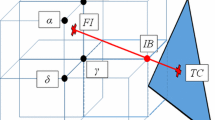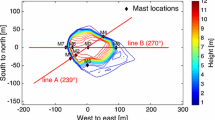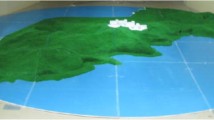Abstract
We present modified immersed boundary method (IBM) for complex terrain flow analysis which is done on coarse grid and based on large-eddy simulation (LES). The main idea is that IBM force to make fluid velocity perpendicular to terrain surface zero and to revive tangential fluid velocity near the terrain surface is applied at Lagrangian point on terrain surface. For smoothing out the effect of IBM force on coarse grid, IBM force at Lagrangian point is distributed on collocated grid and gathered at the position of fluid velocity on staggered grid. For validation of our method, we conduct complex terrain flow analysis for mountainous terrain which is mock-up model of coastal region in Gyeongju and compare our simulation results with wind-tunnel experiment results and other simulation using ANSYS. Our simulation results show better agreement with wind-tunnel experiment results than ANSYS simulation results and properly capture various flow characteristics occuring in complex terrain.
Similar content being viewed by others
Abbreviations
- u i :
-
Fluid velocity for i direction
- p :
-
Pressure
- τ ij :
-
Subgrid-scale stress tensor
- ρ :
-
Density of air
- ν :
-
Kinematic viscosity of air
- ν T :
-
Eddy viscosity
- C v :
-
Vreman model coefficient
- C s :
-
Smagorinsky model coefficient
- x :
-
Position of Eulerian grid point
- X l :
-
Position of Lagrangian point
- X j :
-
Position of intersection point
- ΔA :
-
Surface area of a Lagrangian point
- ΔV :
-
Volume of a Lagrangian point
- Δv :
-
Volume of an Eulerian cell
- u s i :
-
Fluid velocity on staggered grid for i direction
- u c i :
-
Fluid velocity on collocated grid for i direction
- U i :
-
Fluid velocity at Lagrangian point in tensor notation
- F i :
-
Force on Lagrangian point in tensor notation
- U l :
-
Fluid velocity at Lagrangian point in vector form
- F l :
-
Force on Lagrangian point in vector form
- U l n :
-
Normal component of Ul to terrain surface
- U lt :
-
Tangential component of Ul to terrain surface
- C :
-
The constant for near-slip condition
- f s i :
-
Force due to IBM on staggered grid for i direction
- f c i :
-
Force due to IBM on collocated grid for i direction
References
B. G. Kim, C. Lee, S. Joo, K. C. Ryu, S. Kim, D. You and W. S. Shim, Estimation of roughness parameters within sparse urban-like obstacle arrays, Boundary-Layer Meteorology, 139(3) (2011) 457–485.
K. Moon, J. M. Hwang, B. G. Kim, C. Lee and J. Choi, Large-eddy simulation of turbulent flow and dispersion over a complex urban street canyon, Environmental Fluid Mechanics, 14(6) (2014) 1381–1403.
J. Nam and C. Lee, Real-time prediction of urban flow and dispersion, Journal of Mechanical Science and Technology, 35 (2021) 4565–4574.
R. L. Simpson, C. H. Long and G. Byun, Study of vortical separation from an axisymmetric hill, International Journal of Heat and Fluid Flow, 23(5) (2002) 582–591.
G. Byun and R. L. Simpson, Structure of three-dimensional separated flow on an axisymmetric bump, AIAA Journal, 44(5) (2006) 999–1008.
T. Persson, M. Liefvendahl, R. E. Bensow and C. Fureby, Numerical investigation of the flow over an sxisymmetric hill using LES, DES, and RANS, Journal of Turbulence, 7 (4) (2006).
R. Bose and D. H. Yeo, Simulations of flow over an axisymmetric hill, NIST Report (2021).
M. Uhlmann, An immersed boundary method with direct forcing for the simulation of particulate flows, Journal of Computational Physics, 209(2) (2005) 448–476.
J. Bao, F. Katopodes and K. A. Lundquist, Large-eddy simulation over complex terrain using an improved immersed boundary method in the weather research and forecasting model, Monthly Weather Review, 146(9) (2018) 2781–2797.
F. Roman, V. Armenio and J. Frohlich, A simple wall-layer model for large eddy simulation with immersed boundary method, Physics of Fluids, 21(10) (2009) 101701.
J. Jang and C. Lee, An immersed boundary method for nonuniform grids, Journal of Computational Physics, 341 (2017) 1–12.
J. K. Kim, H. K. Jo, H. Kim, K. S. Hwang, Y. S. Gil, S. W. Jeong, M. K. Pack, J. R. Kim, W. B. Kim, Y. C. Ha, J. Hwang, J. K. Hwang, K. P. Jo, Y. B. Jeong, H. D. Kim, S. K. Kim and K. Moon, DB construction for wind load in region for transmission support and wind-tunnel test, KEPCO Report (2010).
Acknowledgments
We are grateful to the Agency for Defense Development of Korea for the support (UD180049GD).
Author information
Authors and Affiliations
Corresponding author
Additional information
Jaewook Nam received his B.S. (2018) from Yonsei University, Seoul, Korea., in Mechanical Engineering. He is an integrated Ph.D. student in the School of Mathematics and Computing, Yonsei University, Korea. His research interests include Large-eddy simulation, immersed boundary methods, and the area of incompressible fluid dynamics.
Changhoon Lee received his B.S. (1985) and M.S. (1987) from Seoul National University, Seoul, Korea and Ph.D. (1993) from UC Berkeley, USA., in Mechanical Engineering. He is a Professor in the School of Mathematics and Computing and Department of Mechanical Engineering, Yonsei University, Korea. His research interests include fundamentals of turbulence, particle-turbulence interaction, numerical algorithms, air pollution modeling and stochastic process.
Rights and permissions
About this article
Cite this article
Nam, J., Lee, C. An immersed boundary method for complex terrain flow analysis. J Mech Sci Technol 36, 1817–1824 (2022). https://doi.org/10.1007/s12206-022-0318-0
Received:
Revised:
Accepted:
Published:
Issue Date:
DOI: https://doi.org/10.1007/s12206-022-0318-0




